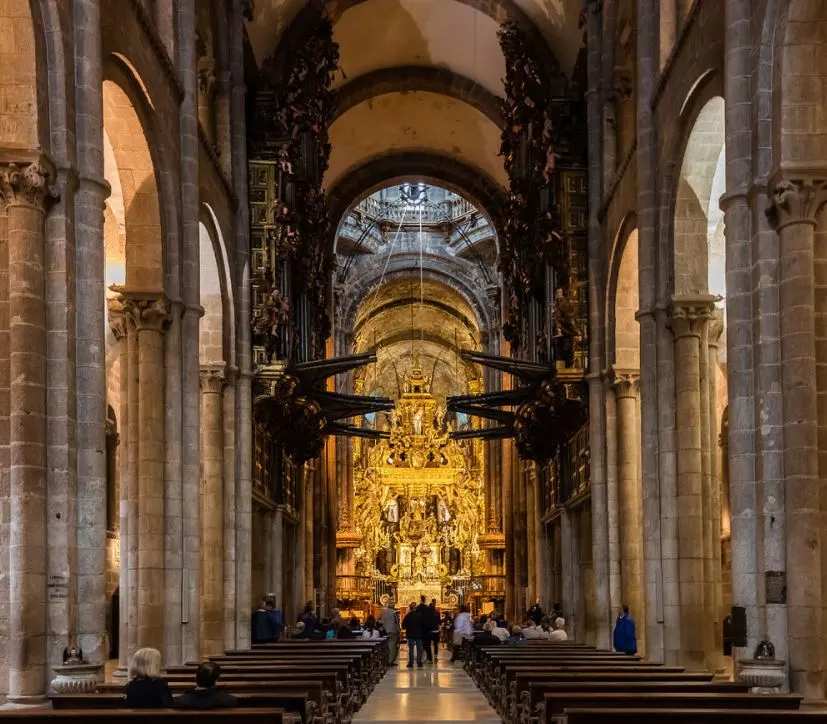Very few Roman Catholic churches in the world have such significant importance as this one. That’s why this wonderful Gothic Cathedral is considered to be one of the 12 treasures of Spain as well.
In this post, we’ll take a closer look at some interesting Santiago de Compostela Cathedral facts, one of the most famous churches in the world!
1. The cathedral is located in the northwest of Spain
The Santiago de Compostela Cathedral is located in the city with the same name in the autonomous community of Galicia in the northwest of Spain.
Even though this is a relatively small city with less than 100,000 inhabitants, the cathedral is one of the most famous Roman Catholic buildings in the world.
It has been designated as a UNESCO World Heritage Site in 1985, along with multiple other structures in the Old Town as it’s described as one of the “most beautiful urban areas in the world,” featuring various Romanesque, Gothic, and Baroque buildings.

2. It was built in a very special location
There’s a reason why this particular town has one of the most important cathedrals in the world. That’s because it’s believed that it was built on top of the final resting place of Saint James the Great, one of the 12 apostles of Jesus Christ.
According to popular belief, he is the one who brought Christianity to the Iberian Peninsula. This means that he had a very important role in spreading the religion in Spain, but also all across the world.
One of the most remarkable Santiago de Compostela Cathedral facts is that it’s just 1 of 3 cathedrals that are presumably built on top of the burial site of an apostle of Jesus. The other two are St. Peter’s basilica in Rome and St. Thomas Cathedral in Chennai, India.
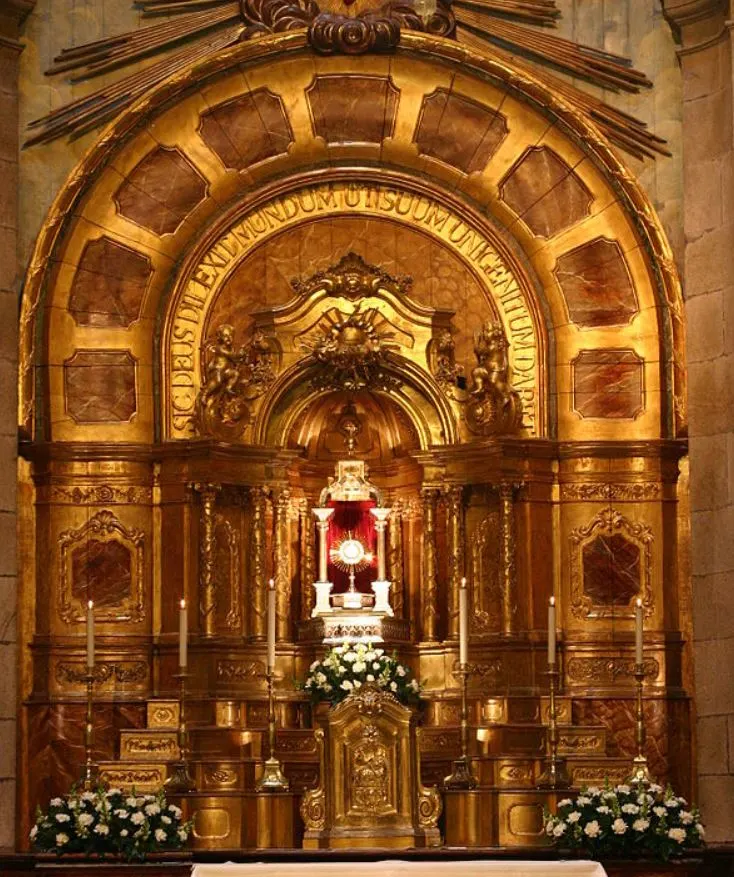
3. It’s the endpoint of a very famous pilgrimage route
Because of this notion, the cathedral has played a very important role for pilgrims all across Europe, starting in the Early Middle Ages in the 9th century.

The cathedral is the traditional end of an extended network of pilgrimage routes referred to as the “Camino de Santiago,” or “The Way of St. James” in English.


4. The first pilgrim was a king who built the 9th-century chapel
Whether or not the church was built on the real tomb of Saint James the Great remains uncertain. We need to believe a legend that mentions that a man saw strange lights in the sky in the year 814 A.D., followed by the discovery of the tomb.
This event was recognized as a miracle by Bishop Theodomirus of Iria and the king at the time, Alfonso II of Asturias and Galicia (791–842). He commissioned the construction of a chapel on the location where the tomb was supposedly rediscovered.
He visited the chapel after it was completed which made him the first pilgrim to visit the shrine.

5. The original church was destroyed but its bells and gates are still in use
The first church on the site was completed just 15 years after the tomb of Saint James the Great was rediscovered in the year 829 A.D. This original, pre-Romanesque church was then expanded at the end of the 9th century.
When the Caliph of Córdoba tried to expand his territory and laid siege to Santiago de Compostela, he ordered his commander to loot and destroy the church, which is exactly what he did in the year 997 A.D.
The bells and gates of the original church were transported all the way south to Córdoba and installed in the local Mosque, now known as the “Mosque-Cathedral of Córdoba.”
They didn’t stay there, however, because Córdoba was taken by King Ferdinand III of Castile in 1236. He ordered his troops to get those bells and gates back so they ended up being transported once again, now north to the city of Toledo, where they were installed in the Cathedral of Saint Mary of Toledo.

6. The church was modeled on a famous Romanesque cathedral in France
Even though the original church was destroyed at the end of the 10th century, the rebuilding project started in the following century in the year 1075.
Even though the building was further designed in the Gothic and Baroque architectural styles, the core structure was completely built in the Romanesque style using granite as its main material.
The engineers got a lot of inspiration from the Basilica of Saint-Sernin in Toulouse, a church that was built between 1080 and 1120 and is considered the largest remaining Romanesque building in Europe.
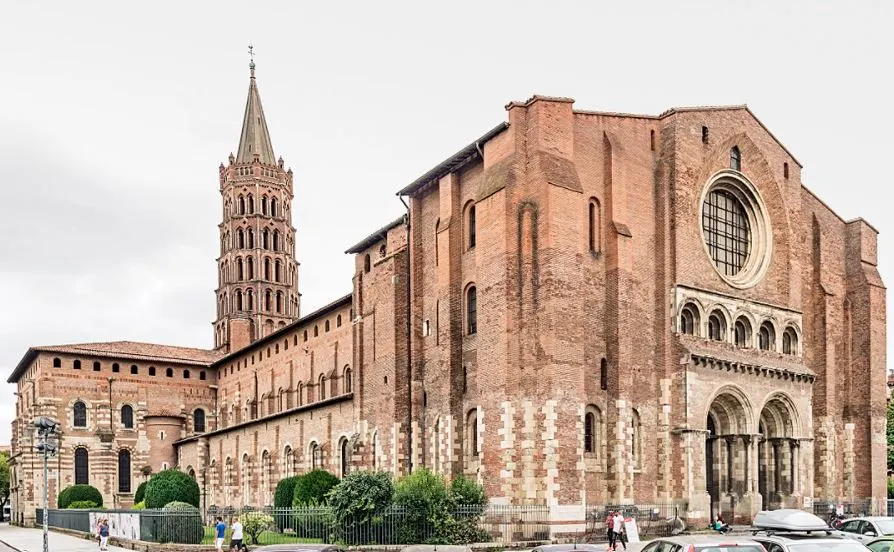
7. It took 136 years before the cathedral was completed
The groundbreaking of the cathedral officially happened in the year 1075, but it wasn’t consecrated until the year 1211, an event that happened in the presence of king Alfonso IX of Leon. This means that it took a total of 136 years before the church was consecrated after the first stone was laid.
Then again, this timeframe wasn’t completely unusual, and even today, the Sagrada Familia in Barcelona isn’t finished after construction started in the year 1882!
The most astounding example of long construction timeframes is Cologne Cathedral in Germany, a church that took a total of 632 years to complete!
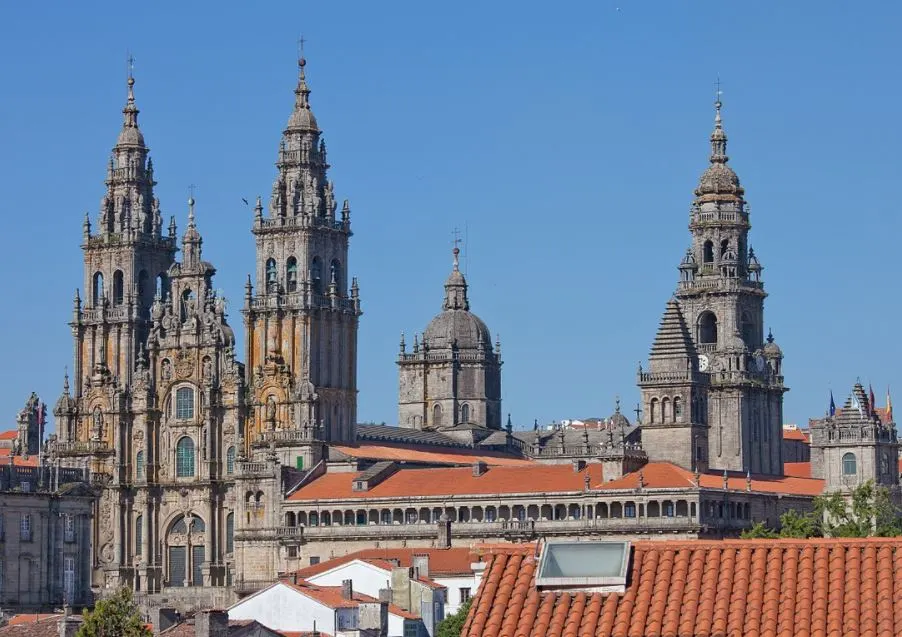
8. The Portico of Glory was completed in the 12th century
One of the most fascinating features of the cathedral is the so-called “Pórtico da Gloria,” which translates to the “Portico of the Glory.”
This portico consists of 3 round arches that are in line with the naves of the church with the central arch being twice as big as the ones on the side. The arches are supported by large piers and pilasters and feature various sculptures, including those of the apostles and a representation of the Last Judgement.
This magnificent Romanesque artwork was commissioned by King Ferdinand II of León and completed by Master Mateo, a local sculptor and architect, and his workshop in the year 1188. We know the exact year because this date is carved into the church.
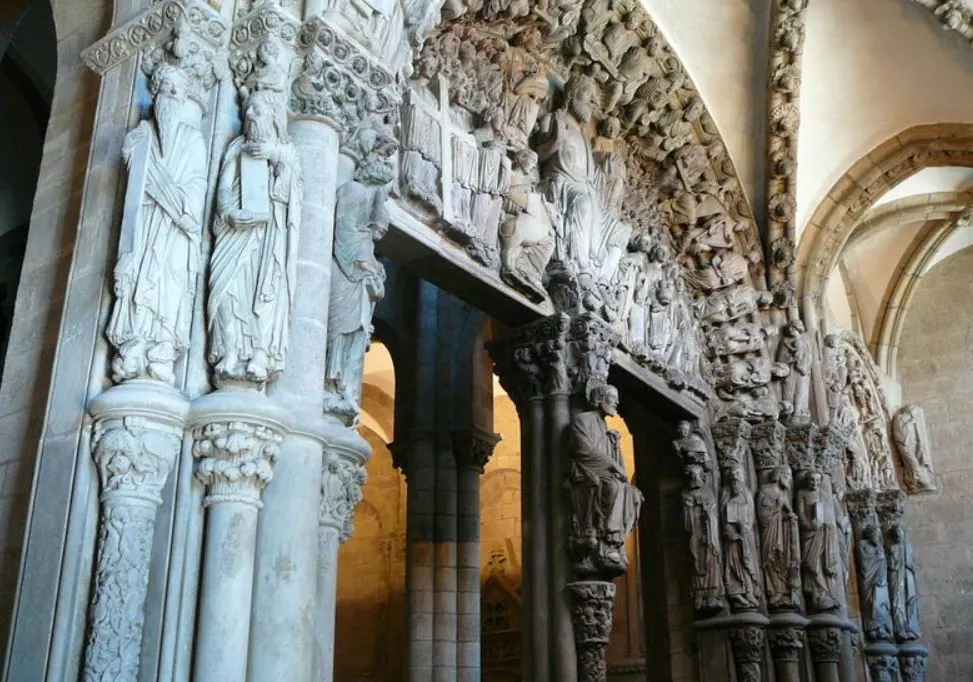
9. Saint James can be found on the middle pier of the Portico
Even though all 12 Apostles of Jesus Christ are sculpted inside the portico, you don’t have to put in a lot of effort to locate Saint James the Great. Yes, that’s right, he’s the one depicted on the middle pier!
Perhaps one of the most interesting Santiago de Compostela Cathedral facts is that these sculptures didn’t look grey and gloomy upon completion. They were polychromed which means this was a remarkably colorful entrance to the church.
Today, only a few traces of color on the sculptures inside the portico remain.
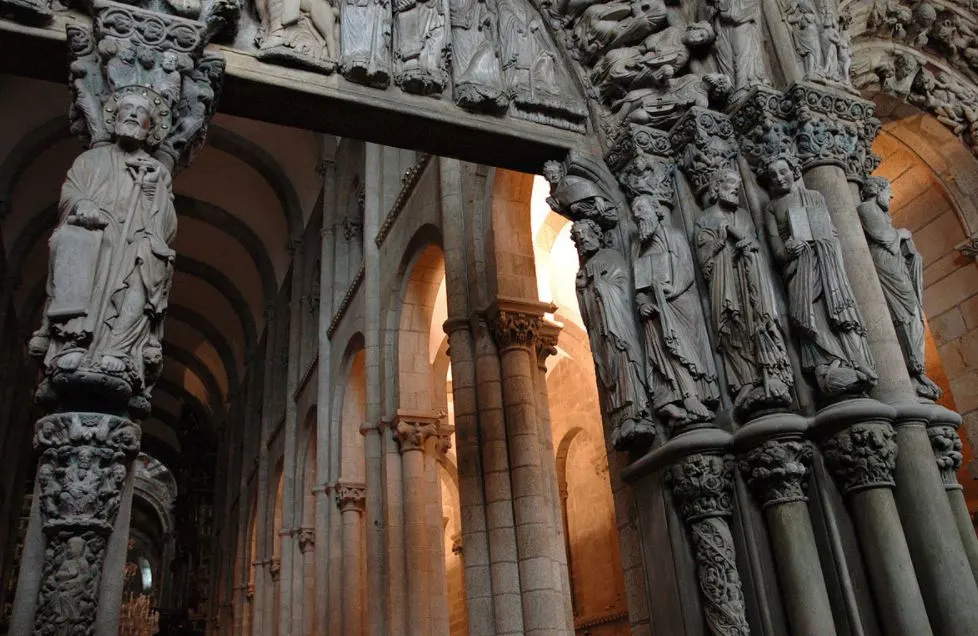
10. The main Baroque façade was built in the 18th century
Even though the building was mostly built in the Romanesque architectural style, multiple additions to it were made in the 15th, 16th, 17th, and 18th centuries.
One of the earliest modifications was made to the Romanesque bell towers in 1483. These towers are called the “Torre das Campás” (right) and the “Torre da Carraca” (left) and have a height of 75 and 80 meters (246 and 262 feet) respectively.
The most prominent modification was made to the cathedral’s “Façade of the Obradoiro,” a feature located between the bell towers that was completed in the 18th century in the Baroque Style.
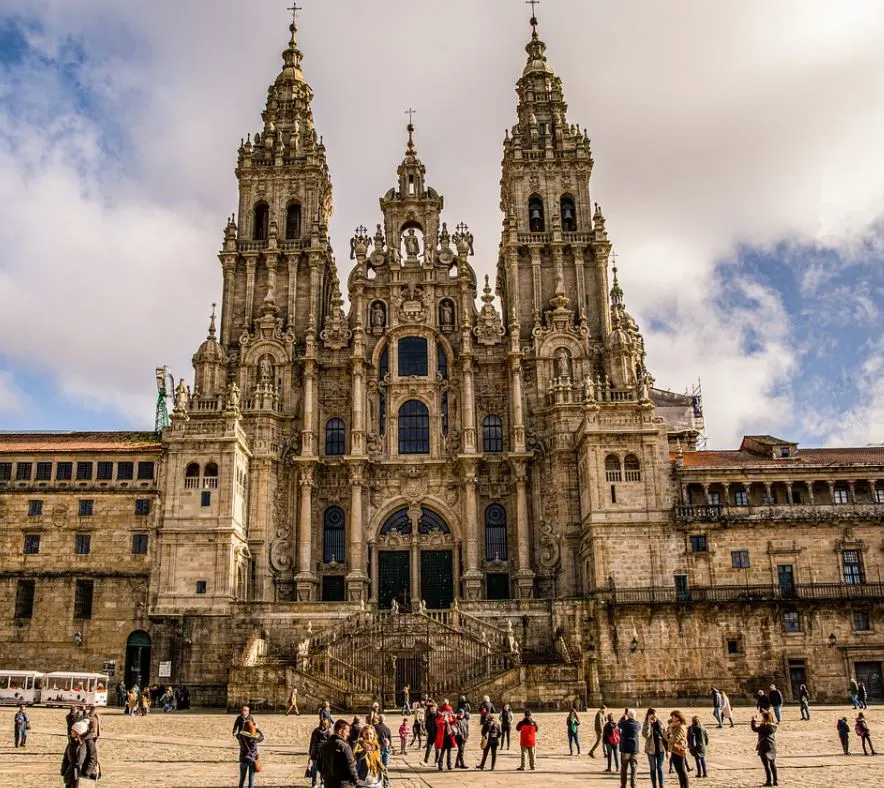
11. It’s the largest originally Romanesque church in Spain
While the church isn’t nearly as big as the largest Gothic church in Spain, the Cathedral of Seville, it still holds a remarkable record. It has a total length of about 100 meters (330 feet) and a width of 70 meters (230 feet).
This makes it the largest Romanesque Cathedral in Spain (the core structure) and one of the largest of its kind in Europe as well!
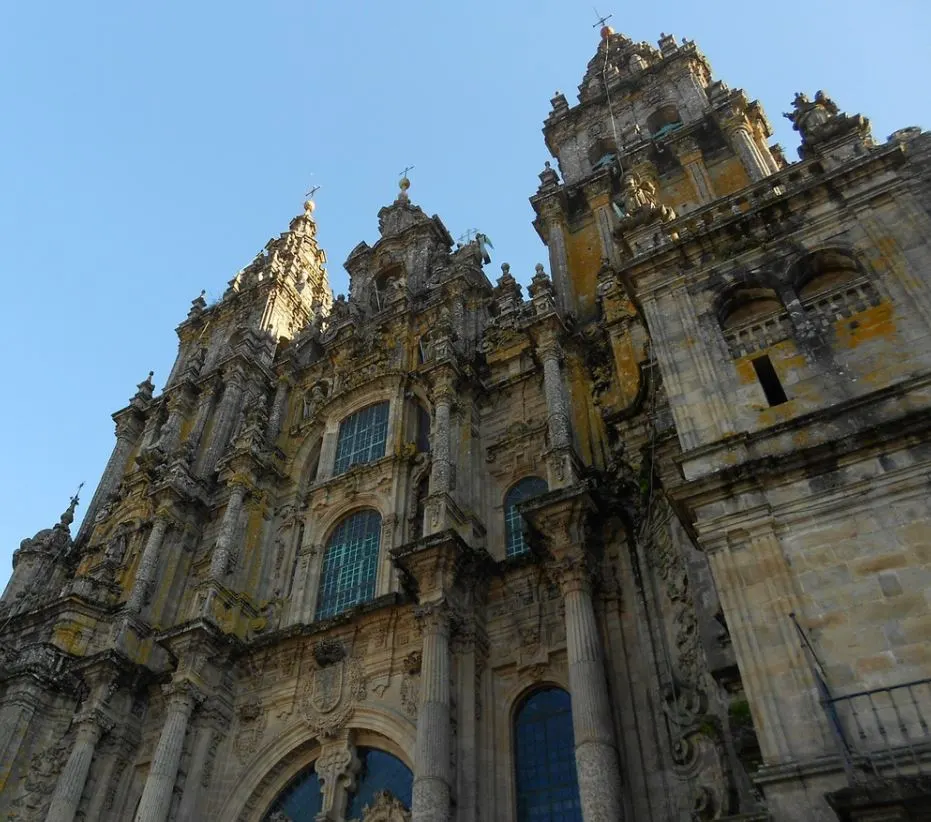
12. The interior of the church becomes more impressive as you go further
So how does the interior of the Cathedral of Santiago de Compostela look like?
Well, not that impressive initially! You really need to go further and get past the monotonous first section of the cathedral and all the way to the organ and the choir which are both heavily decorated and awe-inspiring!
